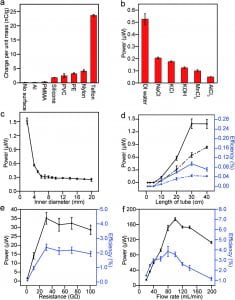The world needs technologies that can generate clean and renewable energy, and especially those that are inexpensive to operate. Gravitational energy of water is known to be one of them, conventionally in the form of hydroelectricity. However, hydroelectricity suffers from critical disadvantages including ecosystem damage and siltation of rivers from construction and operation. Therefore, alternate methods are desired to establish a truly sustainable renewable energy source.
Another way to generate clean electricity is by contact electrification, a ubiquitous charge separation phenomenon that occurs at all times in nature and daily life. However, only insulating materials, which charge heavily after contact, separate a significant amount of charge through contact electrification. Thus, this electric charge is hard to utilize directly.
By exploring charge separation at the solid-liquid interface resulting from contact electrification, we found that the gravitational energy of water alone can generate a significant amount of power through contact electrification. This method involving solid–liquid interface for developing electrification (SLIDE) is clean, renewable, and is available in abundance naturally, such as in rivers, and rain. In addition, using water to separate charge at the water–solid interface overcomes the typical barrier in harvesting energy from contact electrification involving two solid surfaces. We achieved a power of up to ~170 mW per tube continuously in our previous study after optimizing the various factors influencing the system.
By using only commonly-available materials (e.g., Teflon), it can be scaled up easily. One way of scaling up SLIDE is to build multiple L-shaped channels connected together to form a 2-D tray and stack multiple layers in the third dimension. A two-dimensional tray of 5 meters wide can easily fit 500 channels in one layer. If we stack 20 trays in the third dimension, the power generated from this solid structure can be amplified (from a single L-shaped channel) by a factor of 104. If we multiply this factor with the power generated by SLIDE under ideal conditions, this structure can potentially generate a power on the order of ~1W. In addition, we found experimentally that the water can be reused repeatedly to generated energy, thus it can be possible to operate SLIDE in multiple sequential stages. It is possible for a structure of this dimension to be placed in common areas, such as on rooftops.
Resources
- Sun, Y.; Huang, X.; Soh, S.* Using the Gravitational Energy of Water to Generate Power by Separation of Charge at Interfaces. Chemical Science 2015, 6, 3347-3353.


